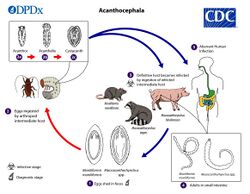Biology:Neoncicola
| Neoncicola | |
|---|---|
| Scientific classification | |
| Domain: | Eukaryota |
| Kingdom: | Animalia |
| Phylum: | Acanthocephala |
| Class: | Archiacanthocephala |
| Order: | Oligacanthorhynchida |
| Family: | Oligacanthorhynchidae |
| Genus: | Neoncicola Schmidt, 1972 |
Neoncicola is a genus of parasitic worms containing nine species and belongs to the family Oligacanthorhynchidae.[1]
Taxonomy
Description
Species
There are nine species in the genus Neoncicola.[2][3][lower-alpha 1]
- Neoncicola artibei Smales, 2007[4]
Neoncicola artibei was found infesting the Great fruit-eating bat (Artibeus lituratus). The species was named after the genus of the host, Artibeus.[4]
- Neoncicola avicola (Travassos, 1917)
- Neoncicola bursata (Meyer, 1931)
- Neoncicola curvata (von Linstow, 1897)
- Neoncicola novellae (Parona, 1890)
- Neoncicola pintoi (Machado-Filho, 1950)
- Neoncicola potosi (Machado-Filho, 1950)
- Neoncicola sinensis Schmidt & Dunn, 1974[5]
- Neoncicola skrjabini (Morosow, 1951)
Hosts
The life cycle of an acanthocephalan consists of three stages beginning when an infective acanthor (development of an egg) is released from the intestines of the definitive host and then ingested by an arthropod, the intermediate host. The intermediate host of M. myrmecobius is inferred to be termites, the main diet of the numbat.[8] When the acanthor molts, the second stage called the acanthella begins. This stage involves penetrating the wall of the mesenteron or the intestine of the intermediate host and growing. The final stage is the infective cystacanth which is the larval or juvenile state of an Acanthocephalan, differing from the adult only in size and stage of sexual development. The cystacanths within the intermediate hosts are consumed by the definitive host, usually attaching to the walls of the intestines, and as adults they reproduce sexually in the intestines. The acanthor are passed in the feces of the definitive host and the cycle repeats. There are no known paratenic hosts (hosts where parasites infest but do not undergo larval development or sexual reproduction) for Neoncicola.[9]
Neoncicola has been found parasitizing bats.[4] There are no reported cases of Neoncicola infesting humans in the English language medical literature.[7]
- Hosts for Neoncicola
The Great fruit-eating bat is a host of Neoncicola artibei
Notes
- ↑ A binomial authority in parentheses indicates that the species was originally described in a genus other than the present genus.
- ↑ There are no known aberrant human infections for Neoncicola species.[7]
References
- ↑ "Neoncicola Schmidt, 1972" (in en). https://www.gbif.org/species/2499641.
- ↑ Amin, Omar M. (September 19, 2013). "Classification of the Acanthocephala". Folia Parasitologica 60 (4): 273–305. doi:10.14411/fp.2013.031. PMID 24261131.
- ↑ "Neoncicola Schmidt, 1972". November 3, 2023. https://www.itis.gov/servlet/SingleRpt/SingleRpt?search_topic=TSN&search_value=196627#null.
- ↑ Jump up to: 4.0 4.1 4.2 Smales, Lesley R. (2007). "Oligacanthorhynchidae (Acanthocephala) from Mammals from Paraguay with the Description of a New Species of Neoncicola". Comparative Parasitology 74 (2): 237-243. https://bioone.org/journals/comparative-parasitology/volume-74/issue-2/4271.1/Oligacanthorhynchidae-Acanthocephala-from-Mammals-from-Paraguay-with-the-Description-of/10.1654/4271.1.short.
- ↑ Schmidt GD, Dunn AM (1974). "Neoncicola sinensis sp. n. (Acanthocephala: Oligacanthorhynchidae) from China.". J Parasitol 60 (4): 626-7. PMID 4853322. https://www.ncbi.nlm.nih.gov/entrez/eutils/elink.fcgi?dbfrom=pubmed&tool=sumsearch.org/cite&retmode=ref&cmd=prlinks&id=4853322.
- ↑ CDC’s Division of Parasitic Diseases and Malaria (April 11, 2019). "Acanthocephaliasis". Center for Disease Control. https://www.cdc.gov/dpdx/acanthocephaliasis/index.html.
- ↑ Jump up to: 7.0 7.1 Mathison, BA (2021). "Human Acanthocephaliasis: a Thorn in the Side of Parasite Diagnostics". J Clin Microbiol 59 (11): e02691-20. doi:10.1128/JCM.02691-20. PMID 34076470. PMC 8525584. https://doi.org/10.1128%2FJCM.02691-20.
- ↑ Smales Lesley R. (1997) Multisentis myrmecobius, gen. et. sp. nov. (Acanthocephala: Oligacanthorhynchidae), from the Numbat, Myrmecobius fasciatus, and a Key to Genera of the Oligacanthorhynchidae. Invertebrate Systematics 11, 301-307. https://doi.org/10.1071/IT95023
- ↑ Schmidt, G.D. (1985). "Development and life cycles". Biology of the Acanthocephala. Cambridge: Cambridge Univ. Press. pp. 273–305. https://core.ac.uk/download/pdf/17218255.pdf. Retrieved 16 July 2023.
Wikidata ☰ Q3830440 entry
 |


